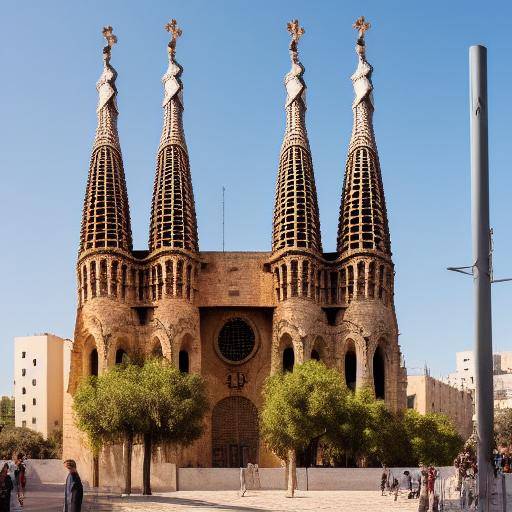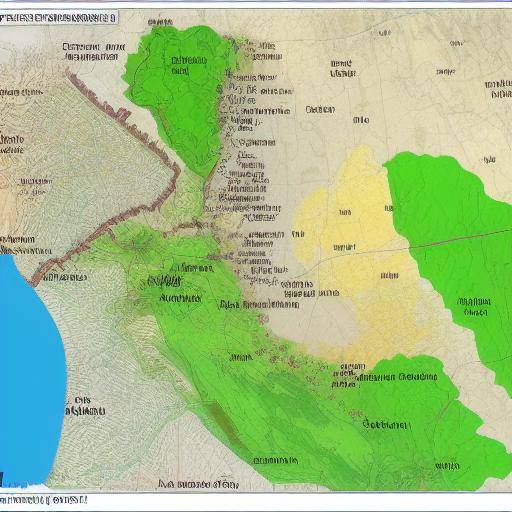
Jerusalem, the city of the world's three most outstanding monotheistic religions, is a place where religious architecture intertwines with historical heritage in a unique way. Its sacred structures and ancient walls tell ancient stories that offer a fascinating perspective on architectural evolution over the centuries. In this article, we will explore architecture in Jerusalem from its historical origins to current trends, providing a deep understanding of its cultural and religious importance.
Introduction
The city of Jerusalem, with its moving ruins, monuments and sacred structures, represents one of the world's cultural epicentres. This ancient city has witnessed countless historical events and has been the scene of profound architectural changes over the centuries. In this context, it is crucial to explore the religious architecture and historical heritage that shape the unique identity and atmosphere of Jerusalem.
History and Background
Origins of Architecture in Jerusalem
The architectural history of Jerusalem dates back to millennia, with vestiges dating from the Bronze Age. The first constructions, such as the walls of the city and the defensive structures, marked the beginning of a rich architectural tradition that has endured to date. The cultural influences of civilizations such as Canaanites, Hebrews, Romans, Byzantines and Arabs are intertwined in the architecture of Jerusalem, creating a unique fusion of constructive styles and techniques.
Evolution to the Length of the Century
Religious architecture has played a fundamental role in the configuration of Jerusalem, with the construction of temples, synagogues, churches and mosques that reflect the spiritual beliefs and practices of the communities that have inhabited the city over the centuries. This architectural heritage, with prominent examples such as the Wall of Lamentations, the Church of the Holy Sepulchre and the Dome of the Rock, is an invaluable legacy that transcends religious and cultural boundaries.
Impact of Historical Events
Significant historical events, such as the Persian conquest, Roman domination, the Crusades, Ottoman occupation and modern conflicts, have left an indelible mark on the architecture of Jerusalem. Urban transformations, monumental reconstructions and territorial disputes have shaped the architectural landscape of the city, revealing the complexity of its historical heritage and its deep connection with political and religious tensions.
Current Situation and Challenges
Today, Jerusalem faces significant challenges in preserving its architectural heritage in the face of urban growth, demographic pressure and political conflicts. The sustainable management of historical heritage, the integration of new technologies in the conservation and promotion of responsible cultural tourism are key themes that seek to ensure the long-term preservation of architecture in Jerusalem, ensuring its relevance for future generations.
Analysis in Deep
Cultural and Religious Importance
The religious architecture of Jerusalem exerts a profound influence on the cultural, social and spiritual life of its inhabitants and visitors. Sacred structures act as meeting points, reflection and pilgrimage for millions of people seeking a sense of connection with the divine and the historical. The symbolic relevance of places such as the Wall of Lamentations, the Church of the Holy Sepulchre and the Mosque of Al-Aqsa transcends religious differences and intertwines with the collective identity of humanity.
Contemporary Architecture Developments
In addition to preserving its rich historical legacy, Jerusalem has experienced a contemporary architectural rebirth with the emergence of innovative buildings and structures that seek to integrate harmoniously into the existing urban landscape. Sustainable design, reinterpretation of traditional styles and the incorporation of cutting-edge technologies are key aspects that reflect the evolution of architecture in Jerusalem, infusing new meanings and functions in the architectural fabric of the city.
Preservation and Restoration
The preservation and restoration of historical structures constitute a crucial field of action in the context of Jerusalem. The conservation techniques, studies of constructive pathologies and restoration interventions are carried out in order to protect and give life to historical monuments and buildings, guaranteeing their legacy for future generations. This commitment to the preservation of architectural heritage shows the intrinsic value that Jerusalem gives to its past and its cultural identity.
Integral Exploration
Comparison with Other Sacred Cities
Compare the architecture of Jerusalem with other sacred cities, such as Mecca, Varanasi, Rome or Kyoto, reveals significant similarities and contrasts in terms of architectural styles, ceremonial functions and spiritual meanings. These comparisons enrich the global understanding of religious architecture and show how every sacred city weave its identity around its architectural heritage and its unique cultural context.
Contemporary Applications in Jerusalem
The historical and spiritual value of the architecture in Jerusalem is also manifested in the contemporary design of public buildings and spaces that seek to reflect the cultural heritage of the city. The integration of traditional architectural elements into new projects, respect for the urban scale and preservation of iconic views are key aspects that reflect a conscious approach to continuity and innovation in the architectural landscape of Jerusalem.
Perspectives of Future Experts and Trends
The perspectives of architects, urbanists, historians and religious leaders provide a deep insight into future trends in the religious architecture of Jerusalem. The balance between the preservation of architectural heritage and the incorporation of new creative expressions, as well as the management of tourist influx and the reconciliation of divergent interpretations, are themes that will mark the architectural evolution of the city in the coming decades.
Conclusions and FAQs
Conclusions
The architecture in Jerusalem, in its fusion of history, religion and creativity, reveals a monumental legacy that transcends the earthly borders to connect with the divine and the human. Its preservation, reinterpretation and continuity reflect the intrinsic importance of religious architecture as the bearer of memories, meanings and hopes for current and future generations.
Frequently asked questions
1. What is the importance of the Wall of Lamentations in the religious architecture of Jerusalem?
The Wall of the Lamentations, also known as the Kotel, is one of the most sacred sites of Judaism, which represents the last vestige of the Second Temple of Jerusalem. Its importance lies in its historical, spiritual and place of prayer and pilgrimage for the Jewish community.
2. What is the role of religious architecture in promoting cultural tourism in Jerusalem?
Religious architecture acts as a magnet for cultural tourism, attracting visitors from different parts of the world who seek to connect with a rich spiritual, historical and architectural heritage.
3. How are the challenges of preserving historical heritage in Jerusalem in the modern era addressed?
The challenges of preserving the historical heritage in Jerusalem are addressed through the implementation of conservation laws, the application of restoration technologies and the promotion of responsible tourism that values the history and sacredness of architectural monuments.
4. What role does the religious architecture of Jerusalem play in interreligious dialogue and peaceful coexistence?
The religious architecture of Jerusalem serves as a symbolic bridge between communities, fostering mutual respect and facilitating interreligious dialogue in a context of spiritual and cultural diversity.
5. How are elements of contemporary design integrated into the religious architecture of Jerusalem without compromising its historical authenticity?
The integration of contemporary design elements into the religious architecture of Jerusalem is carried out with deep respect for historical authenticity, preserving the essence and meaning of the sacred sites while adapting to contemporary needs and expressions.
6. What are the future trends in the religious architecture of Jerusalem in the context of a globalized world?
Future trends in the religious architecture of Jerusalem include an approach to sustainability, the digital preservation of architectural heritage and the promotion of intercultural creativity, with a view to balancing tradition and innovation.
Conclusion
The architecture in Jerusalem is a living testament to the unique intersection between faith, history and human creativity. From the ancient walls of the city to the majestic sacred structures, each building tells a story that transcends the time and connects the hearts of people around the world. In understanding the profound importance of the religious architecture and historical heritage of Jerusalem, we can appreciate its legacy as a beacon of hope, understanding and lasting beauty.
This article has sought to unravel the complexities and wealth of architecture in Jerusalem, from its historical origins to contemporary trends, in the hope of providing an enriching vision of one of the most iconic cities in the world. As we continue to explore the architectural wonders of Jerusalem, let us remember that every structure is more than stone and mortar: it is a living witness of faith, resilience and human creativity.

